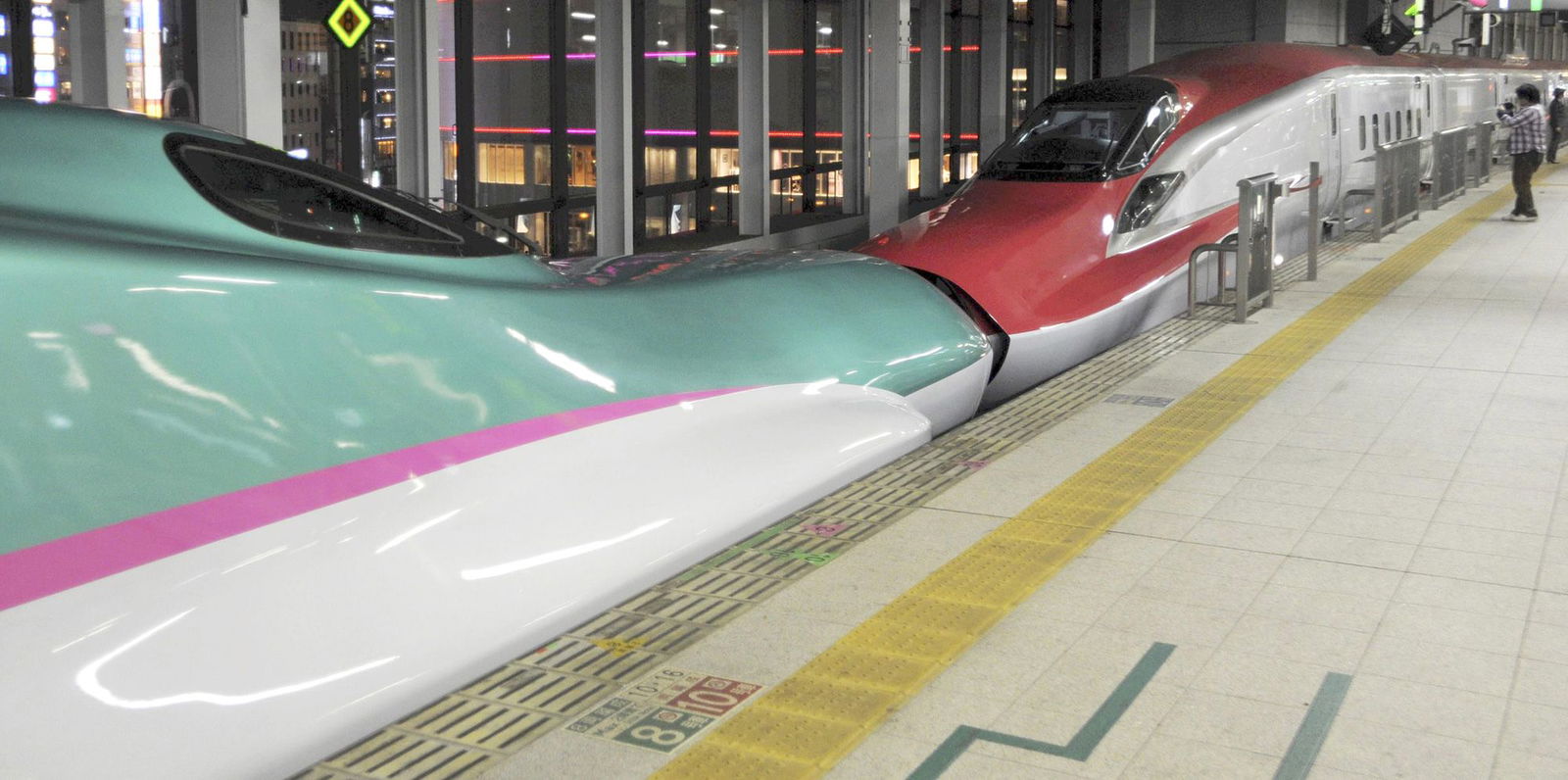The ‘Shinkansen kiss’: Japan’s little-known rail spectacle that attracts trainspotters from around the world

JR East Japan Railway Company conducts its first test operation with Tohoku Shinkansen's E5(green) coupled with Akita's E6 (red) between the Sendai and Kitakami Station
By Joshua Korber Hoffman, CNN
(CNN) — In Japan, finding a true hidden gem seems harder than ever. In recent years, the cities of Tokyo, Kyoto and Osaka have become staples for most international tourists who visit.
But the adventurous visitor only needs to travel just a few hours north of the capital to find a less crowded city, where culinary delicacies can be eaten against the backdrop of a snow-capped, active volcano.
Morioka is perhaps most famous for its noodle-eating challenge and a popular summer festival. But inside its train station awaits one of Japan’s most curious treasures.
A spectacle to get the hearts of rail fans racing, it happens 17 times a day, and there is always a crowd waiting at the platform to see it.
First, the teal green Tohoku Shinkansen “Hayabusa” — one of Japan’s world-famous bullet trains — arrives at the platform. It stops, passengers alight, and the train waits patiently for its partner. Then, the bright red Akita Shinkansen “Komachi” slowly approaches along the same track. Finally, to the excitement of onlookers, the front of the trains open up, and they connect, nose-to-nose.
The technical term for the event is “coupling,” but it is known colloquially as the “Shinkansen kiss.” For Japanese rail fans, it’s a big deal. For foreigners, it is a unique insight into the quintessentially Japanese experience of trainspotting.
“It is the iconic image of the two Shinkansen being connected at the noses,” Carissa Loh, a rail enthusiast from Singapore, tells CNN.
She has joined the crowds to watch the kiss more than five times, noting that for anyone who knows about Japanese trains, the scene at Morioka station is “very, very recognizable.”
Riding trains vs. photographing them
The Japanese are proud of their sleek, spaceship-like Shinkansen, known worldwide as “bullet trains.” They are famously fast, reliable and beautifully designed.
In Japan, explains Loh, rail fans are divided into two main categories: nori-tetsu — “people who like to ride trains” — and tori-tetsu — “people who like to take photos of trains.” Every month, timetables for all the trains are published in “a very thick book,” and hobbyists “will look at it to see where they should go to take a specific photo or to ride a specific train.”
In particular, said Loh, Japanese children love their trains.
“A lot of little boys, when you ask them what they want to be when they grow up, they will say they want to be a Shinkansen driver,” said Loh, “And they can recognize the different trains by the colors and the models. A lot of the people who are (in Morioka) watching are parents bringing their children.”
The Shinkansen network connects the Tokyo metropolitan area to various regions of the country, serving approximately 14 million passengers every day, according to the East Japan Rail Company. At Morioka, the two trains connect and then travel together towards the capital, allowing passengers to go between Akita and Tokyo without needing to transfer. The teal green Hayabusa, the fastest train in the network, pulls along the red Komachi.
‘A moving experience’
Morioka is one of three stations in Japan where you can witness the kissing of two Shinkansen trains, along with Sendai and Fukushima. It is the only place you can witness the colorful kiss between the Tohoku and the Akita.
You can also see the “uncoupling” of the trains at Morioka, as they separate and head in different directions – a sad image in contrast to their joyful union.
It is “a moving experience to watch the mechanical and smooth kissing of the large Shinkansen car body under the exquisite control of the driver,” a representative of the East Japan Railway Company told CNN.
It also adds to the already seductive charm of Morioka, a city of fewer than 300,000 people, often seen as an unlikely stop in a tour of Japan.
“It’s not really a place that first-time visitors to Japan would visit,” said Loh.
But that perception might be changing. In 2023, Morioka was placed second on the New York Times’ list of “52 Places to Go,” only behind London. The Times described the city as “a walkable gem without the crowds, just a short bullet train ride from Tokyo.”
Morioka is known for its old buildings and numerous boutiques, as well as its noodle dishes, according to the East Japan Rail Company. With the added allure of what Loh describes as the “special experience” of the Shinkansen kiss, the northern city has the potential to rival the more popular destinations in the south.
“Most people travel towards Kyoto and Osaka,” said the East Japan Rail Company. “(But) there are many interesting locations north of Tokyo to explore.”
The-CNN-Wire
™ & © 2025 Cable News Network, Inc., a Warner Bros. Discovery Company. All rights reserved.

